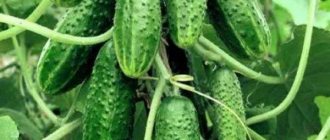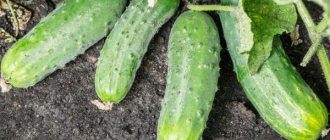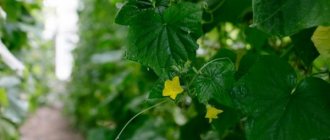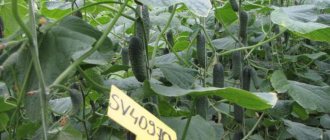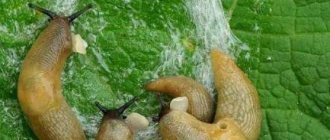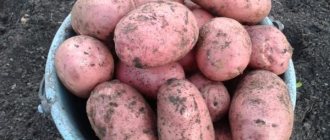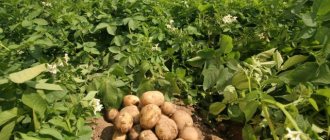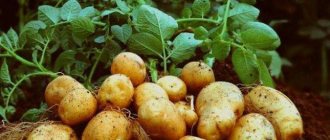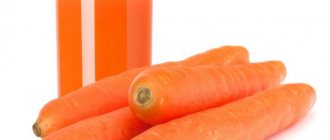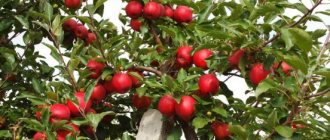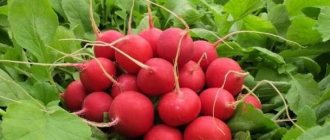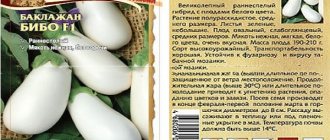The Trilogy cucumber is a parthenocarpic hybrid that has won the appreciation of gardeners justified by its characteristics. The variety's seeds are produced by the Dutch company Rijk Zwaan Zaadteelt En Zaadhandel BV (Rak Zwaan). Trilogy cucumbers are proposed for cultivation in the North-Western and Central regions of the Russian Federation. Since 2011, the variety has been registered in the State Register, with E.I. Golovatskaya and M.G. Kudryavtsev recognized as the authors. The article is devoted to a description of the Trilogy cucumber variety, photos and the nuances of its cultivation.
Description of Trilogy F1 cucumbers
The Trilogy F1 cucumber variety is very young, it was bred by Dutch breeders (Rijk Zwaan Zaadteelt En Zaadhandel BV). It was added to the State Register of the Russian Federation in 2011 for the Central and North-Western regions. It is a first generation hybrid, as indicated by the F1 formula, and belongs to self-pollinating (parthenocarpic) plants.
According to the ripening period, it is classified as a mid-early variety. From the moment the seeds are planted to the ripening of the first wave of fruits, no more than 60 days pass. With proper care you can get a high yield.
The plant is low-growing with medium branching, indeterminate with unlimited growth of the central trunk. Since the length of the trunk can reach more than 1.5 m, it needs a garter; trellises are used for this. Pinching is also necessary to stop growth.
The main feature of the plant of the Trilogy F1 variety is that only the main trunk produces fruits, while the side shoots are very weak and do not bear fruit.
Flowering is stable, since the plants are self-pollinating, only female flowers appear. The fruit ovaries are well developed; on average, 3-4 ovaries can appear in one leaf axil.
The fruits are cylindrical in shape with a dark green color. The skin has spots and short light stripes. The pubescence is medium, the surface is finely tuberculate, the spines are white. The average length of one cucumber is 10 cm, and the weight varies from 60 to 80 g. The diagonal is approximately 3-4 cm.
Trilogy cucumber: variety description, photo
FermoVed.ru » Vegetable growing » Cucumbers » Description of the cucumber variety Trilogy
501
articles
Kira Stoletova
The Trilogy variety is a hybrid plant that appeared quite recently, with medium ripening periods, and is self-pollinating. The Trilogy cucumber quickly spread throughout the Russian Federation, thanks to its excellent yields and strong immunity.
Description of the cucumber variety Trilogy
Characteristics of the variety
The peculiarity of this variety is that the Trilogy F1 cucumber can self-pollinate; it does not need neighbors or bees for this. Trilogy reproduces by bunching, that is, all the fruits are concentrated on the main column, and the side shoots are weak to fully ripen.
For the first time, 8 shoots are formed on the bush, which ripen after 50 days. The productivity of Trilogy is amazing, all the fruits appear and ripen steadily, for this they need a lot of light, the quality and juiciness of the fruits will depend on it.
Gherkins of this type are universal; they are perfect for both fresh use and for making pickles and canning.
Description of the plant
The plant is quite strong, has average ripening rates, 51-59 days pass from the moment of planting to the moment of harvesting the first harvest. Most often, the variety is used to grow in open soil, and for greenhouse conditions there are other varieties of this variety from an earlier period.
The bushes can grow more than 2 m in height. The plants have average branching and weak lateral shoots; almost all of them have a female type of flowering.
Description of fruits
You can see small pimples on the fruits, and there are also small white spikes on the green skin. Cucumbers reach 10 cm in length and weigh 75 g.
Cucumbers have excellent taste; they are juicy, with crispy flesh and a complete absence of bitterness. The yield of plants of this type is 655 centners per 1 ha. In addition, the variety can withstand transportation over long distances. The main thing is to store the fruits correctly and maintain the temperature.
Advantages and disadvantages
Trilogy F1 has managed to establish itself on the positive side. The main advantages of the type:
- easy to transport;
- keeps its presentation for a long time;
- has excellent productivity;
- characterized by the harmony of plant seedlings;
- is resistant to most diseases;
- easily tolerates sudden changes in temperature.
The only negative side of this species is its poor resistance to downy mildew. As soon as the disease hits the plant, after a few days the bush dies, since it cannot resist such a disease at all.
Planting cucumbers
Seedlings are planted in heated soil
Cucumbers of this variety can be grown both by seedlings and without seedlings. Often, seeds are planted a month before direct planting on the site.
Seeds must be soaked before planting: this speeds up the growth of shoots. Seedlings are planted in open ground when the ground has warmed up sufficiently. This usually happens at the end of May.
When using the seedless method, sprouted seedlings are sown only in soil heated to 15 °C. The depth of this type of planting is 2 cm, plant density is 7 bushes per 1 square meter. m.
The soil
The soil for this type of cucumber must be loosened so that it can retain moisture. It is also constantly fertilized so that the bushes receive a sufficient amount of vitamins.
The root system of this type is small; to fertilize it, they dig a trench no more than 40 cm deep: this is the optimal size for organic fertilizer and constant watering of plants.
Decaying organic matter creates a fairly large amount of heat, which allows for accelerated plant growth and fruit development. The plant is fed throughout the season.
Growing space
The landing site should be sufficiently sunny and protected from winds on all sides. Corn is used as a human shield.
Temperature
The optimal temperature for plant growth is not lower than 15 °C and not higher than 30 °C. Too low a temperature leads to the death of the plant or to the cessation of its development. In extreme cases, bushes are insulated with an organic additive or film.
Review of hybrid cucumbers in a greenhouse. July 2021 //Secrets of good harvests.
The best varieties of cucumbers for 2021. What seeds should be planted in a greenhouse and open ground?
Early ripening “parthenocarpic” cucumbers for greenhouses. Tips and secrets. Issue 26
How to grow cucumbers. Varieties and hybrids.
Conclusion
Trilogy is a unique plant that can survive in any conditions, the main thing is to adhere to planting conditions, monitor the temperature and do not forget to water the plants throughout the season.
Description and characteristics of the variety
Although the manufacturer of the Trilogy F1 cucumber is the company Rijk Zwaan from Holland, it was created by Russian specialists taking into account the local climate. It was included in the State Register in 2011, and its creators are E. Golovatskaya and M. Kudryavtsev. The hybrid is zoned for breeding in the Central and North-Western regions of Russia. But according to reviews from gardeners and experienced gardeners, it bears fruit well in other areas with temperate and warm climates, as well as in Ukraine and Moldova. The optimal conditions for cucumbers are open ground. But it can also be planted in a greenhouse; additional pollination is not necessary, since it is parthenocarpic. Indeterminate bushes need support. The fruits ripen 50-58 days after the sprouts appear. They are collected in bouquets, each of which contains 3-4 greens. The length of the cucumbers is 8-10 cm, gherkin type. The diameter reaches 4 cm. The weight ranges from 65 to 100 g. The skin is covered with faint tubercles. There are white spines and not very dense pubescence. The pulp has a pleasant aroma, crunches, and excellent taste. Universal use.
Description of the Trilogy cucumber variety, features of cultivation and care
Trilogy cucumber is a mid-early gherkin-type hybrid intended for cultivation in open ground.
The branching of the plant is average, the flowers are only female. An indeterminate type variety that does not require pollination. Each leaf axil bears 3–4 fruits. They ripen in 55–60 days from the moment the seeds are planted in the ground.
Growing technology
To grow this variety, you should choose the most fertile plot of land. Planting seeds in open ground or seedlings in closed ground is done to a depth of 10–12 cm. The soil temperature should not be lower than 15–17 ˚С
It is important to know that parthenocarpic cucumbers cannot be placed in a plot next to bee-pollinated ones.
The harvest is produced by the central stem. In view of this, it is recommended to remove all side shoots up to the trellis, leaving only the ovaries.
The main stem is wrapped around the trellis and fixed every 55–70 cm, keeping 2 side shoots at each node. The rest are removed after 4 sheets.
The yield of marketable fruits reaches 320–650 c/ha.
Caring for the variety includes the following mandatory activities:
- Regular watering with warm water.
- Loosening the soil.
- Timely removal of weeds.
- Treatment with mineral fertilizers.
In the first month of fruiting, the variety produces most of the harvest. At this time, the crop needs additional feeding.
Features of watering
It is worth noting that before the first flowers appear, the moisture requirement of this crop is quite low. In this regard, it is recommended to water as rarely as possible and exclusively with warm water, since cold water has a bad effect on the development of bushes. With the beginning of flowering, the plant is watered daily in small portions in the mornings and evenings.
Feeding
Since the roots of cucumbers are not strong enough, it is necessary to use only fertilizers that easily dissolve in water. During the entire growth period, Trilogy is fed no more than 6 times, alternating fertilizers. It is recommended to loosen the top layer of soil between waterings.
Advantages and disadvantages of the variety
The advantages of the Trilogy f1 cucumber include the following features:
- High yield.
- Friendly fruiting.
- Stress resistance.
- Relative unpretentiousness to growing conditions.
A distinctive feature of the variety is its resistance to many diseases, such as cucumber mosaic virus, powdery mildew, and brown spot.
The disadvantage of the hybrid is that during long-term storage it loses its taste.
Gardeners' ratings
Cucumber of the Trilogy f1 variety has been supplied to Russia by the Dutch relatively recently, however, it is already appreciated by many of our compatriots. We invite you to read useful reviews about this variety.
Valentina Borisovna, Krasnodar region, Tikhoretsk: “I have been looking for good gherkins for a long time and found a description of the Trilogy hybrid on the Internet. It turned out to be very worthy, now I plant it every year. Early variety. The fruits are tasty, crispy, smooth. If they outgrow, there won't be any big ones. The only drawback is that the seeds are too expensive compared to others.”
Iraida Aleksandrovna, Yekaterinburg: “Last summer I tried to grow Trilogy for the first time. Planted it with seeds. The harvest was solid and friendly, but the fruiting period was short-lived. The taste is excellent, the skin is thin. Suitable for salting and marinating. Unfortunately, they cannot be stored for a long time.”
The hybrid is excellent, unpretentious, very hardy. I didn’t get late blight, unlike the variety that grew next door. I was pleased with the taste - quite juicy and crispy.
I recommend it to anyone looking for tasty and high-quality gherkins.”
So, the characteristics of Trilogy and opinions about it allow us to conclude that this hybrid is undoubtedly worthy of the attention of gardeners who want to find a high-quality court of gherkins.
Characteristics and description of the hybrid
The Dutch selection Trilogy F1 cucumber appeared on the domestic seed market in 2011. The originator is Rijk Zwaan. The variety is included in the breeding State Register of the Russian Federation. The certificate indicates its orientation towards open ground. In practice, cucumbers are also successfully grown in spring greenhouses.
Attention! The territorial admission of the State Variety Commission applies to the Central and North-Western regions of the country. The manufacturer does not make any restrictions for gardeners from other areas.
The bush of this cucumber is weak-growing. Gherkin type fruits. They can reach a mass of 100 g. At the same time, they rarely exceed 10 cm in length. Because of this, cucumbers turn out full and sometimes form voids inside during heat treatment. The crop is knitted in groups of 1-3 pieces. at every node.
History of selection and description of the variety
The Trilogy variety was bred by Dutch breeders from, and in 2011 included in the state register of the Russian Federation for the Central and North-Western region.
Refers to early ripening varieties grown in open areas. The fruits ripen 50–58 days after the seedlings are planted in the ground. A distinctive feature is the ability to self-pollinate without the help of insects. Important! Most cucumbers are produced in the first month of fruiting, which must be taken into account when applying fertilizers.
The bushes are formed with long branches, with the main stem producing the main crop. The flowers are female and appear in large numbers. The fruits are cylindrical, 8–10 cm long, dark green in color with light side stripes and thin skin. Slightly rough and have light spines. The average weight of one cucumber is 65–100 g. The pulp is juicy, crisp, without bitterness.
Detailed description of the fruits
Fruits are the main goal of vegetable growers. They have a cylindrical shape. The skin on cucumbers is dark green in color, spotted, with small tubercles and medium-density pubescence. The spines are white. Trilogy cucumbers are small, the weight of one is about 70 g, length up to 10 cm, diameter 4 cm. The fruits are the same in shape. The pulp is juicy, crispy, aromatic, without bitterness.
The use of cucumbers is universal. Gherkins are used fresh, for canning, pickling, and preparing vegetable salads.
In this phase they have excellent taste and aroma.
How to grow your own
The hybrid is grown by seedlings and seed methods . It grows well both in open ground and indoors. Plants do not like heavy soils, so they are planted mainly in sandy loam. Recommended ground temperature is +15-17°C.
Good predecessors are onions, carrots, peppers, cabbage . Do not plant cucumbers after pumpkin ones, as there is a high risk of infection with “family” diseases and pest invasions.
Planting by seeds and seedlings
Sowing by seedlings begins in mid-April . Due to poor transplant tolerance, cucumbers are sown immediately in separate containers. To grow seedlings, use light and moisture-absorbing soil with the addition of compost. After filling the vessel with soil, water it and place one seed in each one in the moist soil.
After this, cover with a 1-2 cm layer of soil. At first, watering is carried out carefully - it is recommended to use a spray bottle. The seedlings are removed to a warm, illuminated place where the temperature is maintained at +25-28°C, and covered with glass or film.
Frameless furniture - soft chairs
After the emergence of seedlings, the covering material is removed, and the temperature is lowered by about 10°C and left for five days.
Important! If this is not done, the seedlings will stretch out and be weak.
After 2-3 full leaves appear, the seedlings are planted in open ground . This is done in early May, on beds prepared in advance, in rows. It is recommended to leave the distance between future bushes of the Trilogy F1 hybrid at 40-50 cm. The seeds are placed in moist soil to a depth of 1.5-2 cm and gently sprinkled with soil.
To maintain heat and retain moisture, the bed is covered with film. If the rules of care are followed, fruiting begins on average 40 days after sowing.
Growing in stages and care
After sowing, plants require constant attention. Standard care includes :
- Timely watering. It is carried out in the evening, with warm water, once every three days.
- Weeding - as the weeds grow.
- Loosening - between waterings.
- Feeding . Fertilizers are applied in liquid form and the procedure is combined with watering. The hybrid responds well to a solution of bird droppings and mineral complexes. During the growing season, Trilogy cucumbers are fed 5-6 times with an interval of two weeks.
In hot, long-lasting weather, shading material is used. Harvesting takes place from June to September .
Features of cultivation and possible difficulties
One of the features of a hybrid is its indetermination . Therefore, many inexperienced gardeners have difficulties with the correct formation of plants, which has a great impact on the volume of the harvest.
First of all, the main shoot should be tied to a trellis, the side stepsons should be removed, leaving only the ovaries. At a height of up to 50 cm from the ground, not only the side shoots are cut off, but also the ovaries.
When the central shoot grows to the trellis , it is carefully wrapped around it and pinched after 50-100 cm, leaving 2-3 side shoots at the nodes in this interval. The remaining shoots of the first and second order are pinched after the fourth leaf. The plant regulates the number of ovaries on them independently.
Important! Self-pollinating cucumber hybrids cannot be grown next to vegetable crops pollinated by bees.
Diseases and pests
Hybrid cucumber Trilogy F1 is resistant to :
- brown spot (cladosporiosis);
- cucumber mosaic virus;
- powdery mildew.
The hybrid is moderately resistant to downy mildew.
To prevent diseases and damage by pests, you should:
- follow the rules of agricultural technology;
- weed the plants regularly;
- do not place new crops next to old ones;
- carry out sanitary treatment of agricultural equipment;
- destroy rejected cucumbers and green mass.
Remember that plants get sick more often when they are grown for several years in a row in the same place.
If prevention does not help , and the leaves begin to turn yellow and dry out, then the dead parts of the plant are removed and burned, and the rest is treated with the fungicide “Ridomil”, “Kurzat” or a 0.5% solution of Bordeaux mixture.
Common pests of cucumbers are spider mites, aphids, and thrips. Actellik, Talstar and other drugs are used against them. The biological product “Actofit” is also effective in combating spider mites (its maximum effectiveness is at temperatures above +18-20˚C).
Important! When growing cucumbers in a greenhouse, it is regularly ventilated, since high temperature and humidity stimulate the occurrence of diseases.
Growing and care
Cucumbers require regular watering with heated and settled water. Its temperature should be around +22-25. Water 2-3 times a week in the evenings. Irrigation is adjusted depending on the weather. The bushes are tied to a vertical trellis and shaped. Side shoots must be removed, as they do not produce a harvest, but only weaken the plant. Feed 5-6 times with mineral and organic compounds. Prepare weak solutions:
- manure from cows, horses, sheep;
- chicken droppings;
- wood ash;
- mineral fertilizers - superphosphate, potassium sulfate, urea, potassium and ammonium nitrate;
- fermented herbal infusion.
They are applied at intervals of 2 weeks at the root.
Agricultural technology or proper cultivation
To obtain a good harvest, an important factor is the correct choice of planting site. Preference should be given to a well-lit bed with loose, fertile soil.
Two methods are used for cultivation:
- Through seedlings (the most popular);
- Seedless.
Seed material undergoes preliminary preparation by the manufacturer before sale.
Recommendations for growing by seedlings:
- Seeds are sown in early May;
- For growing, it is advisable to use cassettes or pots with a volume of 500 ml. Before sowing, containers must be disinfected with hydrogen peroxide or potassium permanganate;
- Sowing is carried out in peat or coconut substrates;
- The seeds are buried 1-2 cm, then watered with a spray bottle;
- To create a greenhouse effect, plantings are covered with non-woven material or film;
- Seedlings are grown until 4-5 full leaves appear;
- Also, seedlings are fed two or three times with macro- and microelements.
Sowing seeds in open beds:
- Sowing is carried out in the last days of May - in the first ten days of June, upon reaching the average daily temperature above +17 degrees;
- Sow seeds to a depth of 3-4 cm;
- It is recommended to plant in a two-row manner. The beds are placed at intervals of 80-100 cm, the distance between lines is 60 cm, between bushes - 40 cm;
- No more than 3 seedlings are placed per 1 m2.
Growing
To place the crop, you should choose a sunny place that is protected from the winds. Sandy or light loamy soil is best suited for cucumbers. The crop grows better on the soil on which winter and spring wheat, onions, carrots, cabbage, tomatoes or peppers were previously grown. If you plant after pumpkin crops, the yield will be very low.
Trilogy is planted with seedlings, and the seeds can be sown immediately in open ground. With the seedling method, seeds are planted in early May (3-4 weeks before planting in the ground).
Transplantation of seedlings is carried out after the appearance of 3 full leaves. If a plant has more than 5 leaves, it should be thrown away, because such seedlings will take root slowly or die immediately. Transplanting seedlings into open ground is carried out towards the end of May - beginning of June, when the soil has completely warmed up.
When planting seeds without seedlings, you should wait until the soil warms up to +15°C. Seeds are planted to a depth of no more than two centimeters. The distance between plants should be at least half a meter. Experienced gardeners use the trench type of planting cucumbers. With this method, a trench 40 cm deep is dug, and organic matter is added to the bottom. The soil is sprinkled on top, then the seeds are planted.
When decomposed, organic fertilizers release a large amount of heat, which promotes rapid plant growth and fruit development. Trilogy should be fed with mineral fertilizers throughout the summer season. The best temperature regime for plant growth is not lower than +15°C and not higher than +30°C. Cold weather can lead to stunted growth or even death of the plant, so when it gets cold, you should temporarily cover the plant with film or other covering material.
On the central stem up to a height of 40-50 cm, all lateral stepsons and ovaries should be removed
When it reaches a height of 80 cm, it is pinched and very carefully wrapped around the trellis, leaving only three shoots at the leaf nodes
The largest harvest from a bush can be harvested in the first month of fruiting, so an increased amount of nutrients should be added during this period. "Trilodge" bears fruit very well with regular application of nitrogen and potassium fertilizers.
The “Trilodge” variety is resistant to such major cucumber diseases as cucumber mosaic virus, cladosporiosis, and powdery mildew, but is not resistant to downy mildew. To protect the plants, they should be replanted in the same area after five years. In cool and humid weather, bushes should be protected from possible diseases by spraying them with fungicides twice a season.
It should be borne in mind that before flowering, the water requirement of cucumbers is very low. Watering young plants is carried out rarely and only with water not lower than 20°C, because cold liquid can slow down the growth of the plant. After the first ovary appears, watering is carried out every day in small volumes only in the morning or evening.
Trilogy cucumbers are removed from the garden in a not quite ripe form, when they are still in the gherkin state. Greenhouse cucumbers are harvested daily, and in open ground they are harvested every other day.
Landing
To obtain an early harvest, seedling cultivation is recommended. But in the southern regions and warm countries, cucumbers can be sown directly into the ground when its temperature is +14-16 degrees.
Planting seedlings is needed 25-30 days before transferring them to the garden bed. It is not worth sowing earlier, as overgrown seedlings take root less easily.
The seeds do not require soaking or processing. 1-2 seeds are placed in individual peat pots with a nutrient substrate. It can be purchased at the store or prepared from the following ingredients:
- 1 share of turf soil;
- 1 share of peat;
- 2 shares of humus;
- 0.5 or 1 share of drainage - sand, sawdust or vermiculite.
The planted seeds are moistened and kept in a warm place until the sprouts hatch. Then provide the room with about +18-20 degrees of heat and daylight hours of at least 10 hours.
The bed is chosen in a sunny place where potatoes, peppers, tomatoes, cabbage, corn, onions or legumes were grown before cucumbers. Pumpkin and melons are unsuitable predecessors; they deprive the soil of the substances needed by cucumbers and can leave pathogens of specific diseases there. The site preparation is as follows:
- Dig the ground deeply.
- For every square meter, place a bucket of humus or compost and a glass of wood ash into the soil.
- In a greenhouse, remove the top 7-15 cm of soil and replace with fresh soil.
- Also in the greenhouse you need to disinfect the soil and all surfaces with a solution of potassium permanganate.
- Measure the acidity, and if the pH is above 6-7, then add dolomite flour.
Growing Requirements
Trilogy F1 cucumbers are grown both by seedlings and by direct sowing of seeds in open ground. Planting material must be purchased from trusted companies. Good performance is demonstrated by the seeds of this variety supplied from Holland.
Drop off time
With the seedling method, the seeds are planted in peat pots in early May. The time for their germination to the stage of placement in open ground is approximately 25-30 days. Seedlings are planted in open ground after 2-3 true leaves appear. If the plant has outgrown, then it is better to throw it away, because the seedlings at this stage no longer take root well, and the elongated stem is more susceptible to mechanical damage.
When planting seeds in open ground, sowing work begins at the end of May. A period is selected when the soil at a depth of 3-4 cm warms up to at least 12°C. The plant adapts to rising air temperatures as it grows. But if the temperature suddenly drops to 5 degrees and remains at this level for some time, the seedlings will die.
Soil and crop rotation
Cucumbers prefer sandy loam or light loamy soil, carefully seasoned with organic and mineral fertilizers. It is better to cultivate this crop on soil on which winter wheat, onions, carrots, cabbage, tomatoes or peppers previously grew. Poor yields are observed after planting in soil where pumpkin crops were previously grown.
Plants are planted according to the scheme 3 bushes per 1 sq. m. The seeds deepen by 2-3 cm. Good fruiting indicators of the variety are observed with the trellis growing method.
Scheme of planting cucumbers in a greenhouse
Formation of bushes
As the stems grow, you can regulate the number of ovaries by cutting off the excess ones, since a large number of them can slow down the formation of new fruits. When using trellises, all side shoots are removed from the plant, leaving only those with ovaries. In this case, all side shoots from the bush are cut off up to 40-50 cm above the ground (blinding procedure).
The main stem is carefully wrapped around the trellis as it grows and pinched after 50-100 cm, leaving 2-3 new shoots formed at the nodes of the central vine. On regrown shoots of the first and second order, pinching is done after the 4th leaf.
It should be noted that until flowering, cucumbers have a very low moisture requirement. Therefore, young plants should be watered occasionally and only with warm water, since cold water negatively affects the growth of bushes. Further watering should be carried out daily, in small portions and in the morning/evening.
Feeding
Since the root system of cucumbers is not strong enough, only easily soluble fertilizers are used. Their number is calculated based on the composition of the soil. During the season, cucumbers are fed 5-6 times with alternating mineral and organic fertilizers. Between waterings, the top layer of soil is loosened.
Harvesting
In greenhouses, fruits are picked daily, and in open ground conditions - every other day. The Trilogy harvest from large areas is approximately 330-660 c/ha, which is almost 2 times more than standard varieties.
Trilogy F1 cucumbers can be grown by seedlings and by sowing seeds. The plant takes root well both in open ground and in greenhouse shelters.
When growing outdoors, you must choose a sunny place, protected from the wind. The soil should be sandy loam or light loamy, the optimal soil temperature is 15-17 degrees.
An excellent place for growing cucumbers of this variety is the land where onions, carrots, cabbage, peppers, tomatoes or wheat previously grew. But it is not advisable to plant cucumbers after pumpkin crops, because the yield will be very low.
A friend gave me a couple of beds at her dacha last spring. So I decided to plant greens on one and cucumbers on the other. Still, these crops do not require special care and I do not have to set up a tent for living next to the garden bed.
When I was choosing seeds, the saleswoman advised me to take the Trilogy f1 cucumber. She said that it was of Dutch selection and is well suited for the climate of central Russia. The description also indicated that it could be planted in open ground. I usually don’t read reviews very much, so I looked at it briefly and that’s it.
I don’t know what influenced it, but the harvest turned out to be excellent. It was enough to eat my fill and close so many cans for the winter that now I give gifts to my relatives from time to time.
Drop off time
With the seedling method, the seeds are planted in peat pots in early May. The time for their germination to the stage of placement in open ground is approximately 25-30 days. Seedlings are planted in open ground after 2-3 true leaves appear.
If the plant has outgrown, then it is better to throw it away, because the seedlings at this stage no longer take root well, and the elongated stem is more susceptible to mechanical damage.
The plant adapts to rising air temperatures as it grows. But if the temperature suddenly drops to 5 degrees and remains at this level for some time, the seedlings will die.
Soil and crop rotation
Cucumbers prefer sandy loam or light loamy soil, carefully seasoned with organic and mineral fertilizers. It is better to cultivate this crop on soil on which winter wheat, onions, carrots, cabbage, tomatoes or peppers previously grew.
Poor yields are observed after planting in soil where pumpkin crops were previously grown.
Landing rules
For the Trilogy variety, it is best to choose the most fertile areas of land. The best option would be those beds where peas or other legumes grew last season. When planting seeds in the ground, it is necessary to dig holes 10 cm deep. Planting is recommended when the soil warms up to 15°C, not earlier.
To grow a large harvest, you need to monitor what varieties Trilogy beds will be adjacent to. These cucumbers do not require pollination, so they must be grown separately from those classified as bee-pollinated varieties.
As for diseases, the hybrid is quite resistant to many of them; it is not afraid of the cucumber mosaic virus, brown spot and powdery mildew.
With proper care you can achieve very high yields. If the plant receives enough water and mineral fertilizers, and does not suffer from weeds, you can collect 7 kg of gherkins from each square meter.
Cucumbers require regular watering with heated and settled water. Her temperature should be around 22-25. Water 2-3 times a week in the evenings. Irrigation is adjusted depending on the weather. The bushes are tied to a vertical trellis and shaped. Side shoots must be removed, as they do not produce a harvest, but only weaken the plant. Feed 5-6 times with mineral and organic compounds. Prepare weak solutions:
- manure from cows, horses, sheep;
- chicken droppings;
- wood ash;
- mineral fertilizers - superphosphate, potassium sulfate, urea, potassium and ammonium nitrate;
- fermented herbal infusion.
They are applied at intervals of 2 weeks at the root.
They are grown mainly in open ground by seedlings and by planting dry seeds. For seedlings, seeds are sown in early May in peat pots to a depth of 2 cm. They are planted in the ground at the end of May or early June at an average daily temperature above 17°C to a depth of 3-4 cm according to the 50x30 pattern. Grown by trellis method. The harvest of the Trilogy F1 variety comes from the main stem, so up to the trellis
, leaving only the ovaries, and at a height of 50 cm and above, both side shoots and ovaries are cut off.
The main stem is twisted around the trellis and pinched every 50-80 cm, leaving 2 side shoots at each node. The remaining shoots are removed after the 4th leaf. Standard care - watering, weeding, loosening, fertilizing. Water in the evening with warm water; during flowering and fruiting, the amount of watering is increased. Fertilizing - 5-6 times per season, alternating mineral fertilizers and organic matter.
Cucumber can be cultivated in two ways:
- seedling (more preferable);
- sowing seeds in open ground.
Features of the seedling growing method:
- terms - beginning of May;
- It is optimal to use not boxes, but cassettes or pots (0.5 l);
- sowing is carried out in peat (or coconut) substrates;
- sow seeds at a depth of 1-2 cm;
- water the crops;
- it is advisable to cover the crops with non-woven material or film (if it’s cold) and only with non-woven material (if it’s already hot, in order to avoid “steaming”);
- grow seedlings until 4-5 true leaves grow;
- It is advisable to carry out 2-3 feedings with macro and microelements.
Features of sowing in open ground:
- terms - end of May - beginning of June (when the average daily temperature will be above 17°C);
- sow seeds to a depth of 3-4 cm;
- A two-row planting scheme is recommended (distance between beds - 80-100 cm; distance between lines - 60 cm; distance in line between plants - 40 cm);
- 3 plants per 1 m².
Expert opinion
Filatov Ivan Yurievich, private farmer for more than 30 years
A common mistake when growing in greenhouses is the insufficient number of windows (transoms) in greenhouses. It is optimal if the transom area is about 25% of the total area of the greenhouse. Otherwise, in the morning there will be a sharp increase in air temperature, which is harmful to the plant.
A simple rule for increasing yield is to plant cucumber seeds in the ground where potatoes, cabbage and legumes (except beans) previously grew.
Reviews
Numerous reviews from summer residents characterize the hybrid as high-yielding and disease-resistant .
Vera, Yaroslavl : “I collected 4 kg from a bush. The cucumbers grew small and plump, with small frequent tubercles. The pulp is dense and no holes formed in it when salted. Excellent taste both fresh and canned. After the season, I identified several disadvantages: the bush is difficult to form and is susceptible to changes in air temperature. There are more advantages: excellent taste and appearance, good yield, dislike of frequent watering, resistance to most diseases.”
Lyubov, Ryazan: “I’ve been planting a hybrid for several years now. I give him first place after Masha and German. Very early, the fruits are tasty, even, if they outgrow, they are not large. Late blight does not cause severe diseases and is very hardy. One drawback is its price.”
Care
How to properly care for Trilogy:
- Before the flowering period begins, cucumbers are watered infrequently, using only warm water. Watering with cold water will slow down growth. From the beginning of flowering and beyond, water the plants every day, moderately, in the morning or evening;
- Since cucumbers have a weak root system, it is advisable to use easily soluble fertilizers. The dosage is calculated taking into account the type of soil. During the entire growing season, 5-6 feedings are carried out. Be sure to alternate mineral and organic fertilizers, this will prevent excess amounts of the same nutrients in the soil;
- In the intervals between waterings, loosen the top soil layer;
- Provides the main crop to the central stem. For this reason, it is necessary to remove all lateral stepsons up to the horizontal trellis, leaving only the ovaries. At a height of 40-50 cm from the surface of the ground, not only the side shoots, but also the ovaries are blinding. When the central stem reaches the trellis, it is carefully wrapped around it and pinched after 50-100 cm, without touching 2-3 side shoots at the nodes in this interval. Next, the remaining shoots of the 1st and 2nd order after the 4th leaf are pinched;
- In greenhouse structures, greens are collected every day, from open beds - every other day.
Growing technology
To grow this variety, you should choose the most fertile plot of land.
Planting seeds in open ground or seedlings in closed ground is done to a depth of 10–12 cm. The soil temperature should not be lower than 15–17 °C. It is important to know that parthenocarpic cucumbers cannot be placed in an area next to bee-pollinated ones.
The harvest is produced by the central stem. In view of this, it is recommended to remove all side shoots up to the trellis, leaving only the ovaries.
The main stem is wrapped around the trellis and fixed every 55–70 cm, keeping 2 side shoots at each node. The rest are removed after 4 sheets.
The yield of marketable fruits reaches 320–650 c/ha.
Caring for the variety includes the following mandatory activities:
- Regular watering with warm water.
- Loosening the soil.
- Timely removal of weeds.
- Treatment with mineral fertilizers.
In the first month of fruiting, the variety produces most of the harvest. At this time, the crop needs additional feeding.
Features of harvesting and storage
Since Trilogy F1 cucumbers ripen almost simultaneously, it is recommended to harvest every other day.
The requirements for long-term storage of vegetables are as follows:
- It is best to keep the fruits in a cool, dry basement at a temperature of +4...0°C, so they can be stored for up to 28 days;
- avoid temperature changes;
- select fruits that are fresh, whole, without damage or signs of rotting;
- put the cucumbers in boxes and sprinkle with sand.
Advantages and disadvantages
- The positive properties of the Trilogy F1 cucumber include:
- excellent taste;
- immunity to temperature changes;
- fairly high yield;
- resistance to diseases;
- versatility in cooking;
- good presentation and excellent durability during transportation;
- cucumbers ripen at the same time.
- The disadvantages are:
- instability to peronosporosis;
- the need for garter to the support.
Trilogy F1 has managed to establish itself on the positive side. The main advantages of the type:
- easy to transport;
- keeps its presentation for a long time;
- has excellent productivity;
- characterized by the harmony of plant seedlings;
- is resistant to most diseases;
- easily tolerates sudden changes in temperature.
The only negative side of this species is its poor resistance to downy mildew. As soon as the disease hits the plant, after a few days the bush dies, since it cannot resist such a disease at all.
Pros:
- excellent aroma and taste;
- excellent transportability and commercial quality;
- good yield;
- immunity to many diseases;
- good drought resistance;
- formation of ovaries without pollination;
- stress resistance, slight susceptibility to temperature changes;
- universal purpose.
Minuses:
- It is not possible to obtain your own seeds and must be repurchased annually.
Video
You can also watch a video where an experienced gardener will tell you how hybrid varieties of cucumbers grow in a greenhouse.
So, Trilogy f1 cucumber is recommended to be grown spread out both in greenhouses and in open ground. The crop is characterized by high productivity and stress resistance. The fruits have an excellent appearance, excellent taste, and are excellent for both preparing salads and canning. The small size allows this cucumber to be called a gherkin.
Diseases and pests
Breeders have declared a high degree of hybrid resistance:
- to brown spot (Ccu, cladosporiosis);
- powdery mildew (Px).
There is an intermediate degree of stability:
- to zucchini yellow mosaic virus (ZYMV).
- cucumber mosaic virus (CMV).
For prevention you should:
- proper care;
- suppress weeds;
- avoid placing new crops next to old pumpkin fields;
- the use of reflective mulch film is encouraged;
- sanitization of agricultural equipment;
- destruction of piles of rejected products.
The hybrid has weak resistance to peronosporosis (downy mildew). On the affected leaves, mottling first appears, and then light yellow spots appear. Over time, these spots merge and turn into affected areas, the color of which ranges from yellowish-brown to brown. To defeat the fungus, remove and burn damaged parts of the plant. The remaining ones should be treated with fungicides:
Of the pests, the most harmful to cucumbers are spider mites, aphids, and thrips. You can use Actellik, Talstar, etc. against them. The biological product Actofite is also effective against spider mites (maximum effectiveness at temperatures above 18-20˚C).
Preventive measures are mandatory: at the end of the previous period, a good disinfection should be carried out, then pests, as a rule, appear in late May - early June and do not cause much harm. Chemical pest control is the basic method today.
In greenhouses, large temperature differences and high air humidity can provoke the appearance of diseases and pests.
